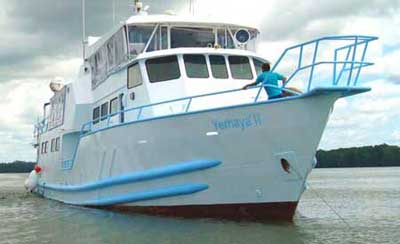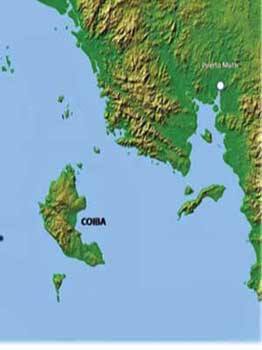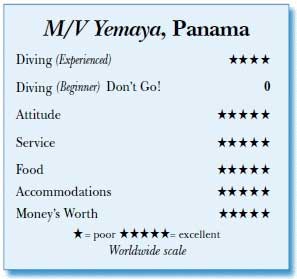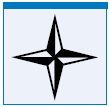M/V Yemaya, Coiba Island, PanamaContents of this Issue: M/V Yemaya, Coiba Island, Panama Hawaii Shark Feeding Tour Controversy Leads to Dismissed Lawsuit and Arson Virgins, Little Cayman, Palau, Sipadan… The Next Generation of Rebreathers: II And the “Green Diver B.S. Award” Goes to . . . Who’s Responsible for a Diver’s Death? Jim Abernethy Catches a Few Teeth Editorial Office: Ben Davison Publisher and Editor Undercurrent 3020 Bridgeway, Suite 102 Sausalito, CA 94965 An alternative to Cocos and Mapelo from the February, 2011 issue of Undercurrent
Dear Fellow Diver: If backrolling into a four-knot current, grabbing a submerged buoy line to descend 100 feet into a field of anemone-covered black coral, and finning over seamounts frequented by schools of tuna, amberjack and pelagics appeals to you, then read on. The Yemaya's captain, David Spell, formerly of the Nekton Rorqual, told me, "If you see the buoy under the surface, don't go." After motoring several hours from the Yemaya's anchorage in Panama's Amazon-like Rio San Pedro to reach the Pacific, then another hour to Isla Afuerita, schools of jumping devil rays welcomed me to Coiba, a 250-square-mile UNESCO Nature Reserve. We traveled around the uninhabited Coiba Island, with anchorages at several locations. Sportfishers know Coiba's Hannibal Bank as a destination
for record-breaking sailfish and marlin. Water temperatures varied from the low 70s to 80 degrees. Visibility, created by thermoclimes, ranged from 10 to 80 feet, and all these differentials sometimes occurred during the same day, or even a single dive. Everyone wore multiple layers. I wore a 5mm over a skin with a hood and gloves. Most dives were as deep as 100 feet and it was easy, without diligence, to lose track of depth. At Christina's Reef, when not distracted by swirling schools of blue trevally and spadefish, I saw an adult rockmover. Juveniles appeared like sideways-moving leaves with horns. Despite seahorses, gobies, frogfish and other small critters, Coiba is not a destination for macro lovers. At Washing Machine, where surge can spin a diver over the top of the seamount, thousands of blue-striped grunt, jacks, blue runners and surgeonfish circled. Diving with Diego, we stayed out of harm's way. Yemaya's spacious dive deck has benches with lifting seat cubbies. Two showerhead hoses are on a lower dive platform. There is a camera rinse tank and shelves, many electrical outlets and an air hose. The two closest heads are on the upper deck. Everyone used Nitrox, and analyzing was required before entering the dinghy. After his boat safety briefing and tour, Adonis-like Diego gave me a water bottle I could refill from a large purified container. All diving was from a Bimini-covered fiberglass dinghy that looked spanking new. When the Yemaya is full, as it usually is when it makes Malpelo and Cocos trips, two dinghies and divemasters are used. Each seat had a tank holder with underseat cubby. There's a sturdy ladder for reboarding, and crew wanted us to board hands-free so we wouldn't fall when there was swell. Rides to dive sites varied between five and 20 minutes. There were occasions when the Yemaya moved a short distance to the next site while we were diving. The crew loaded all our gear, including fins and masks. Lorenzo Pilati, our assistant divemaster-in-training, who had spent most of his dive career in Southeast Asia, and Captain David also dived with us. Green turtles were frequent sightings, and white-tip reef sharks were the norm for most dives. The latter either swam alone or in pairs but sometimes rested in groups on the sand or huddled in cave-like rocks. I also saw schools of jack, manta and eagle rays, electric rays buried in the sand, blue Pacific triggers building their nest, and yellowfin tuna. Strong currents required direct descents, even for those carrying large expensive cameras with multiple strobes. But that didn't apply to me or the other divers, two Frenchmen and a "female friend" of Diego's, who used point-and-shoots. Currents can be too unpredictable to pass around cameras while divers linger on the surface. Diego cautioned us: "If you get lost from the group and find yourself in blue water, surface without making a safety stop. Cross currents can carry you a long distance with everyone going a different direction." So I hung with Diego. Wahoo Alley, our check-out dive, could have been named after its many guitarfish. My descent was faster that the other divers, and with visibility being so poor, I missed the group. After watching a large school of wahoo, followed by schools of barracudas and jack, whizz by, I headed up to abort the dive, and Diego, a welcome sight, found me soon after. Despite carrying a video camera, Diego kept an eye on all of us. He was excellent at pointing out both small critters and anything of size above us. He tended to swim fast, sometimes unavoidably, against the current, burning up the air of the other divers, including that of Lorenzo and Captain David. I was grateful for his strength and skills, but his female buddy, who was there writing an article for a Costa Rican publication, was definitely a distraction. Between morning dives, they would frequently kayak to a nearby beach. While the Frenchmen and I were always on time for our 8 a.m., 11 a.m., and 3 p.m. dives, we sometimes had to wait for the couple. Once we had to stop the dinghy to retrieve a cap she left on the beach. On one dive, when she ran out of air, she surfaced too quickly. Instead of returning for an additional safety stop to prevent DCS, Diego lowered her computer to 15 feet for eight minutes. I think Diego evaluated that she was physically OK and didn't want her computer to lock up. She borrowed a photo card reader, diving gloves and a camera, and downloaded everyone's photos into her computer. Then there were her special requests for food, forgetfulness and utter lack of dive etiquette. Wish I could get my hands on her finished article, if it ever got written. However, the crew of eight, all from Panama, couldn't have been more helpful. They were gracious, warm and conveyed their friendliness with very little use of English. At Prosper Rock, we were cautioned about surge that could carry us sideways about 10 feet. A school of six large whitetips, waiting for their night feeding, rested on the bottom, along with several sizable southern stingrays and crowns of thorns. Yemaya uses a dropped anchor line to descend and ascend on many dives. At Roller Coaster, I backrolled into a school of circling barracuda. Humpbacks circled the buoyed mooring but departed as we approached. Strong incoming currents brought large red snappers, and jacks. Frijoles could have been named after white-tips rather than refried beans. Schools of silver and striped spadefish circled us, and I was lucky enough to come across two frogfish, some free swimming morays, a few lobster, and another octopus. Gorgonia and sponges dwelled among the rocks. While there were a couple options for night dives, Diego gave the experience a poor review. With the cold water, we all passed. Diego warned against swimming near beaches, saying, "The only inhabitants there are caimans and American crocodiles." The Yemaya is spacious and comfortable, but it's an old, 115-foot-long, steel-hulled boat renovated from service as an industrial workhorse, so it's quirky and a bit of a "rat maze." On my introductory tour of the boat, I was shown this route to my room: Walk to the upper deck, then back down, and either walk through the "always open" bridge or around the bow from the starboard to port deck. Finally, I entered the doorway of a short hallway leading to my master suite. However, on the last day, one of the French divers pointed to a port-type door. "That goes to your room." Wish he had shown me the shortcut a few days before. I enjoyed two large, port-side, curtained
windows, a built-in TV, a full dresser and
drawers under a high platform bed. More storage
there than in my own bedroom. The equally
spacious tiled bathrooms had views from two
full starboard windows that I could see from
my sizable shower, and a sink vanity with
multiple lights over the mirror. The gifted chef, Juan Carlos, changed into his professional hat and jacket for every meal. Eggs were available at 7 a.m., along with fresh fruit, yogurt and cereal. Daily, Juan Carlos made juice from papaya, pineapple, tamarindo, passionfruit and watermelon. After the first dive, he was waiting for us with hot chocolate and a freshly baked empanada or other tasty Panamanian goodies. Our introduction to his dinners, served semi-buffet style on the al fresco upper deck, was a scrumptious filet of corvina grilled in butter with capers and herbs. There was a fresh salad at every meal, sometimes a homemade soup, and fresh vegetables with potatoes or rice. Twice daily, I gorged on the homemade desserts of flan, cakes, mousse, ice cream, and plenty of chocolate, even a milkshake. Entrees were primarily seafood: lobster, shrimp, calamari, octopus, grouper, sea bass, sierra mackerel -- all cooked to perfection. His final meal, a super-sized pan of paella, was incredible. It's incredibly easy to gain weight on this boat, but I enjoyed every morsel. Our last of 14 dives was at Isla Jicarita. Crammed into the crevice of a small rock were four or five white-tips. This is Coiba's version of a muck dive. A seahorse wrapped itself around a coral on the sand, and several sea goddess nudibranchs, eagle rays and a school of bright yellow- and black-striped snapper caught my attention. As the Yemaya lifted anchor to head back to the mainland, a school of bottle-nosed dolphin surrounded us, a farewell to a great dive trip. While Isla Coiba is comparable to the big shark action of Cocos and Malpelo, you're closer to the mainland, skipping the multiple-hour, round-trip treks to those destinations, and enjoying calmer night anchorages. You've still got currents and low visibility to deal with, but for blue-water dive enthusiasts, there's plenty of fish life to go around. --M.S.
|

I want to get all the stories! Tell me how I can become an Undercurrent Online Member and get online access to all the articles of Undercurrent as well as thousands of first hand reports on dive operations world-wide
| Home | Online Members Area | My Account |
Login
|
Join
|
| Travel Index |
Dive Resort & Liveaboard Reviews
|
Featured Reports
|
Recent
Issues
|
Back Issues
|
|
Dive Gear
Index
|
Health/Safety Index
|
Environment & Misc.
Index
|
Seasonal Planner
|
Blogs
|
Free Articles
|
Book Picks
|
News
|
|
Special Offers
|
RSS
|
FAQ
|
About Us
|
Contact Us
|
Links
|
3020 Bridgeway, Ste 102, Sausalito, Ca 94965
All rights reserved.

 For the
diver, Coiba is a deep, open and sometimes rough, bluewater
opportunity to view dense schools of tuna, jack,
mullet, golden rays and, perhaps, a rare sighting of a
billfish. Add jellies into the equation, including stinging
"strings of gold" and mid-water tunicates. At depth,
thick plankton darkens the water. Most of my dives were
75 to 100 feet.
Divemaster Diego
Mejias, who previously
worked
on the Undersea
Hunter, channelled
Forrest
Gump when
talking about
Coiba's totally
unpredictable
diving. "It's
like buying a
box of assorted chocolates and not knowing what you are getting."
For the
diver, Coiba is a deep, open and sometimes rough, bluewater
opportunity to view dense schools of tuna, jack,
mullet, golden rays and, perhaps, a rare sighting of a
billfish. Add jellies into the equation, including stinging
"strings of gold" and mid-water tunicates. At depth,
thick plankton darkens the water. Most of my dives were
75 to 100 feet.
Divemaster Diego
Mejias, who previously
worked
on the Undersea
Hunter, channelled
Forrest
Gump when
talking about
Coiba's totally
unpredictable
diving. "It's
like buying a
box of assorted chocolates and not knowing what you are getting."
 During a day when several giant mantas soared
above, followed by a three-foot green turtle, I
also spotted a nudibranch. The underwater terrain
is largely volcanic rocks.
During a day when several giant mantas soared
above, followed by a three-foot green turtle, I
also spotted a nudibranch. The underwater terrain
is largely volcanic rocks. There was, however, a shortage of hot water. I lucked
out because the two Frenchmen were given the
second master suite, as it had two beds,
along with porthole-type, port to starboard
windows. Rooms on the main dive deck
had bunk beds with regular windows. From
the main deck, I walked to the main hall,
which had a video room and small library but
lacked fish and critter ID books. While the
hall was adjacent to a galley where food was
primarily prepped, most of the cooking was
done on a grill behind a bar on the upper
deck. The stern upper deck held some chaise
lounges for sipping cocktails but after
dinner, we usually headed off to our rooms
to read.
There was, however, a shortage of hot water. I lucked
out because the two Frenchmen were given the
second master suite, as it had two beds,
along with porthole-type, port to starboard
windows. Rooms on the main dive deck
had bunk beds with regular windows. From
the main deck, I walked to the main hall,
which had a video room and small library but
lacked fish and critter ID books. While the
hall was adjacent to a galley where food was
primarily prepped, most of the cooking was
done on a grill behind a bar on the upper
deck. The stern upper deck held some chaise
lounges for sipping cocktails but after
dinner, we usually headed off to our rooms
to read. Divers Compass: Not knowing there were only three paying passengers
(I was told there would be eight), I opted to pay $90 more for a
master suite, for a total of $2,610; ensuite cabins cost $2,650
and shared-bath cabins are $2,400 . . . Yemaya makes seven-day
trips to Coiba, and also combines the island with Malpelo or Cocos
for 9 to 12-day trips . . . Nitrox is an additional $150, and the
park fee is $20 . . . Because of my evening arrival and 6:45 a.m.
pickup (4:45 am on my watch), I stayed at the Country Inn Amador,
a basic Holiday Inn-type hotel on the route to Puerto Mutis, where
the boat is moored . . . When I received bundled charges of $775, Kirsten Treais
of my dive travel agency Amazing Adventurers told me, "This is the way they do
it." I don't know whether it included the single supplement, transportation or another mark because I was unsuccessful in even getting an itemization; it stank
but it was two days before the trip, and how could I cancel? . . . Our shore
visit to Coiba's famous Penal Colony, built between 1903 and 1919, was led by a
former 12-year inmate and it's a not-to-be-missed excursion. Yemaya's website:
Divers Compass: Not knowing there were only three paying passengers
(I was told there would be eight), I opted to pay $90 more for a
master suite, for a total of $2,610; ensuite cabins cost $2,650
and shared-bath cabins are $2,400 . . . Yemaya makes seven-day
trips to Coiba, and also combines the island with Malpelo or Cocos
for 9 to 12-day trips . . . Nitrox is an additional $150, and the
park fee is $20 . . . Because of my evening arrival and 6:45 a.m.
pickup (4:45 am on my watch), I stayed at the Country Inn Amador,
a basic Holiday Inn-type hotel on the route to Puerto Mutis, where
the boat is moored . . . When I received bundled charges of $775, Kirsten Treais
of my dive travel agency Amazing Adventurers told me, "This is the way they do
it." I don't know whether it included the single supplement, transportation or another mark because I was unsuccessful in even getting an itemization; it stank
but it was two days before the trip, and how could I cancel? . . . Our shore
visit to Coiba's famous Penal Colony, built between 1903 and 1919, was led by a
former 12-year inmate and it's a not-to-be-missed excursion. Yemaya's website: 